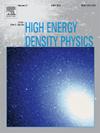Evaluation of tissue-air ratios (TAR) for various tissue-equivalent materials in diagnostic radiology
IF 0.9
3区 物理与天体物理
Q3 PHYSICS, FLUIDS & PLASMAS
引用次数: 0
Abstract
Tissue-air ratios (TAR) are fundamental in diagnostic radiology dosimetry, yet limited data exist for polymethyl methacrylate (PMMA) and epoxy resin in conventional X-ray energy ranges. This study experimentally determines TAR using an epoxy resin phantom and validates the results through Monte Carlo (MC) simulations with the Geant4/GATE toolkit. An epoxy resin phantom (1.20 g/cm³) was fabricated, and optically stimulated luminescence dosimeters (OSLDs) measured dose at depths of 2, 4, 6, 8, and 10 cm within epoxy resin, PMMA, and air. A digital X-ray system (40–150 kV) provided the exposure conditions. MC simulations modeled photon transport with a monoenergetic beam (10–150 keV) and phase-space detectors. TAR results showed epoxy resin closely matched PMMA, with deviations of <5 % at low energies (<60 keV) and increasing up to 8 % at higher voltages (≥100 kV). Compared to water and soft tissue, epoxy resin exhibited TAR deviations within 6 % across all depths, confirming its dosimetric suitability. At higher beam qualities, beam hardening effects led to slight TAR overestimations in epoxy resin compared to water, whereas PMMA demonstrated similar trends but with marginally lower values. Despite these variations, epoxy resin TAR remained within acceptable limits, supporting its application as a soft tissue-equivalent material in dosimetric studies.
诊断放射学中各种组织等效材料的组织空气比(TAR)的评估
组织空气比(TAR)是诊断放射学剂量学的基础,但在常规x射线能量范围内,聚甲基丙烯酸甲酯(PMMA)和环氧树脂的数据有限。本研究使用环氧树脂模体实验确定了TAR,并通过使用Geant4/GATE工具包进行蒙特卡罗(MC)模拟验证了结果。制作了一个环氧树脂模体(1.20 g/cm³),并用光学激发发光剂量计(osld)测量环氧树脂、PMMA和空气中深度2,4,6,8和10 cm处的剂量。数字x射线系统(40 - 150kv)提供了曝光条件。MC模拟了单能束(10 - 150kev)和相空间探测器的光子输运。TAR结果表明,环氧树脂与PMMA非常匹配,在低能量(60 keV)时偏差为5%,在高电压(≥100 kV)时偏差增加至8%。与水和软组织相比,环氧树脂在所有深度上的TAR偏差在6%以内,证实了其剂量学的适用性。在较高的光束质量下,与水相比,在环氧树脂中,光束硬化效应导致TAR略微高估,而PMMA表现出类似的趋势,但值略低。尽管存在这些变化,环氧树脂TAR仍在可接受的范围内,支持其作为软组织等效材料在剂量学研究中的应用。
本文章由计算机程序翻译,如有差异,请以英文原文为准。
求助全文
约1分钟内获得全文
求助全文
来源期刊

High Energy Density Physics
PHYSICS, FLUIDS & PLASMAS-
CiteScore
4.20
自引率
6.20%
发文量
13
审稿时长
6-12 weeks
期刊介绍:
High Energy Density Physics is an international journal covering original experimental and related theoretical work studying the physics of matter and radiation under extreme conditions. ''High energy density'' is understood to be an energy density exceeding about 1011 J/m3. The editors and the publisher are committed to provide this fast-growing community with a dedicated high quality channel to distribute their original findings.
Papers suitable for publication in this journal cover topics in both the warm and hot dense matter regimes, such as laboratory studies relevant to non-LTE kinetics at extreme conditions, planetary interiors, astrophysical phenomena, inertial fusion and includes studies of, for example, material properties and both stable and unstable hydrodynamics. Developments in associated theoretical areas, for example the modelling of strongly coupled, partially degenerate and relativistic plasmas, are also covered.
 求助内容:
求助内容: 应助结果提醒方式:
应助结果提醒方式:


